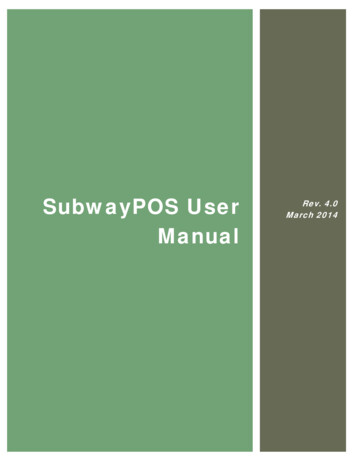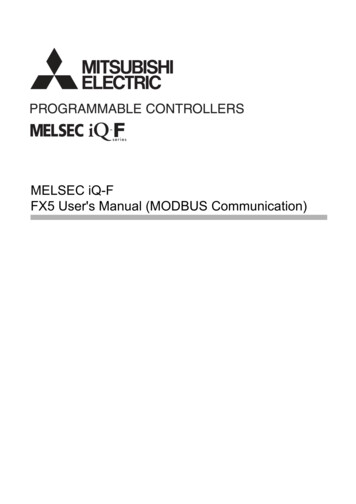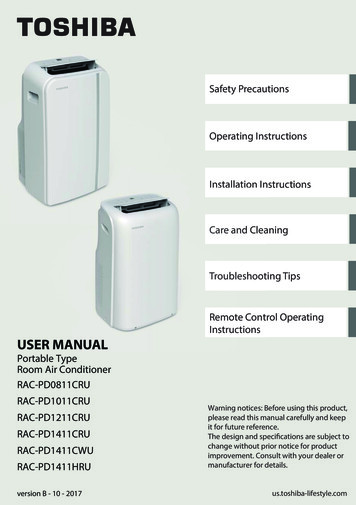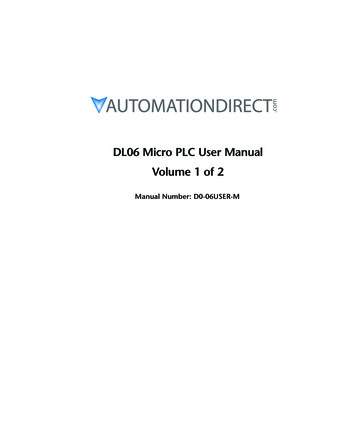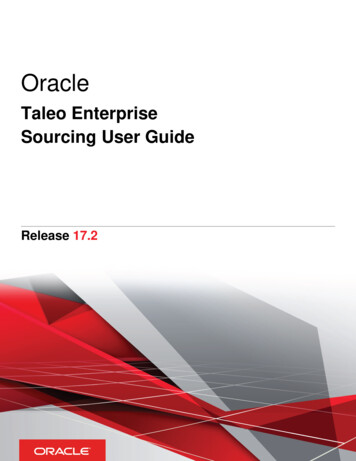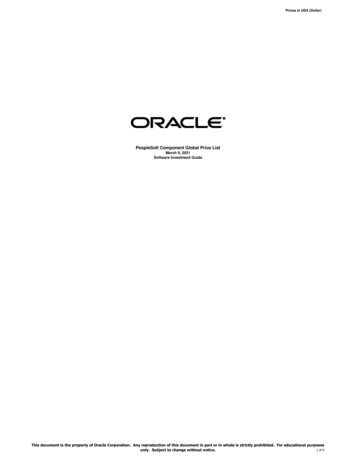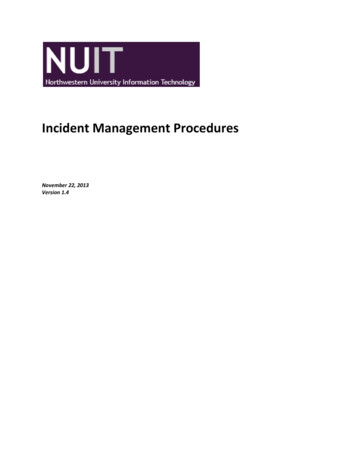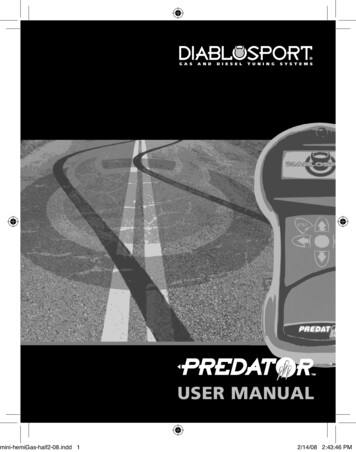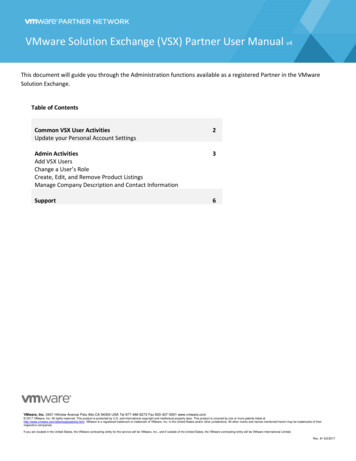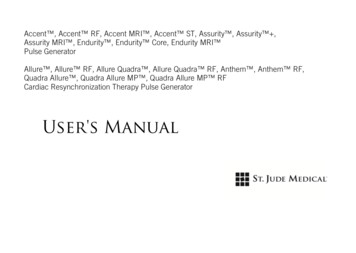
Transcription
Accent , Accent RF, Accent MRI , Accent ST, Assurity , Assurity ,Assurity MRI , Endurity , Endurity Core, Endurity MRI Pulse GeneratorAllure , Allure RF, Allure Quadra , Allure Quadra RF, Anthem , Anthem RF,Quadra Allure , Quadra Allure MP , Quadra Allure MP RFCardiac Resynchronization Therapy Pulse GeneratorUser's Manual
Unless otherwise noted, indicates that the name is a trademark of, or licensed to, St. Jude Medical or one of itssubsidiaries. ST. JUDE MEDICAL and the nine-squares symbol are trademarks and service marks of St. Jude Medical,LLC and its related companies.Pat. http://patents.sjm.com 2017 St. Jude Medical, LLC. All Rights Reserved.
Device DescriptionThis manual describes the St. Jude Medical pulse generators listed in the table below 1.These devices can be programmed with Merlin Patient Care System equipped with Model 3330version 21.2.2 (or greater) software. For information on programming, refer to the programmer's onscreen help.CAUTION: Not all device models are available in all countries.Not all of the products listed as MR Conditional are approved for MR Conditional use inall countries or regions.Before performing an MRI scan on patients implanted with any of these devices,contact St. Jude Medical or consult your regulatory authorities to determine if theproducts have been certified as MR Conditional.Table 1. Pulse generator eMRI Status 2Accent SRPM1110Single-chamber pulse generatorIS-1Untested12Not all device models are available in all countries.As defined by the American College of Radiology.1
Table 1. Pulse generator eMRI Status 2Accent MRIPM1124Single-chamber pulse generatorIS-1MR ConditionalEndurity CorePM1140Single-chamber pulse generatorIS-1MR ConditionalEndurity CorePM1152Single-chamber pulse generatorIS-1MR ConditionalEndurityPM1160Single-chamber pulse generatorIS-1UntestedEndurityPM1162Single-chamber pulse generatorIS-1MR ConditionalEndurity MRIPM1172Single-chamber pulse generatorIS-1MR ConditionalAccent SR RFPM1210Single-chamber pulse generator withRF telemetryIS-1UntestedAccent MRIPM1224Single-chamber pulse generator withRF telemetryIS-1MR ConditionalAssurityPM1240Single-chamber pulse generator withRF telemetryIS-1UntestedAssurity PM1260Single-chamber pulse generator withRF telemetryIS-1Untested2
Table 1. Pulse generator eMRI Status 2Assurity MRIPM1272Single-chamber pulse generator withRF telemetryIS-1MR ConditionalAccent DRPM2112Dual-chamber pulse generatorIS-1UntestedAccent STPM2122Dual-chamber pulse generatorIS-1UntestedAccent MRIPM2124Dual-chamber pulse generatorIS-1MR ConditionalEndurity CorePM2140Dual-chamber pulse generatorIS-1MR ConditionalEndurity CorePM2152Dual-chamber pulse generatorIS-1MR ConditionalEndurityPM2160Dual-chamber pulse generatorIS-1UntestedEndurityPM2162Dual-chamber pulse generatorIS-1MR ConditionalEndurity MRIPM2172Dual-chamber pulse generatorIS-1MR ConditionalDual-chamber pulse generator withRF telemetryIS-1UntestedAccent DR RF PM22123
Table 1. Pulse generator eMRI Status 2Accent MRIPM2224Dual-chamber pulse generator withRF telemetryIS-1MR ConditionalAssurityPM2240Dual-chamber pulse generator withRF telemetryIS-1UntestedAssurity PM2260Dual-chamber pulse generator withRF telemetryIS-1UntestedAssurity MRIPM2272Dual-chamber pulse generator withRF telemetryIS-1MR 20CRT-PIS-1UntestedAllure QuadraPM3140CRT-PIS-1/IS4LLLLUntestedQuadra AllurePM3542CRT-PIS-1/IS4LLLLMR Conditional4
Table 1. Pulse generator eMRI Status 2Quadra AllureMPPM3160CRT-PIS-1/IS4LLLLUntestedQuadra AllureMPPM3562CRT-PIS-1/IS4LLLLMR ConditionalAnthem RFPM3212CRT-P with RF telemetryIS-1UntestedAllure RFPM3222CRT-P with RF telemetryIS-1UntestedAllure QuadraRFPM3242CRT-P with RF telemetryIS-1/IS4LLLLUntestedQuadra AllureMP RFPM3262CRT-P with RF telemetryIS-1/IS4LLLLUntested5
IndicationsImplantation of a single-chamber pulse generator, dual-chamber pulse generator, or CRT-P is indicatedin one or more of the following permanent conditions 3,4, 5: Syncope Presyncope Fatigue Disorientation due to arrhythmia/bradycardia Or any combination of those symptoms.Implantation of a CRT-P is indicated for patients who: Would benefit from resynchronization of the right and left ventricles Have one or more conventional indications for the implantation of a pacemaker3Brignole M, Auricchio A, Baron-Esquivias G. et al. 2013ESC Guidelines on cardiac pacing and cardiac resynchronization therapy: TheTask Force on cardiac pacing and resynchronization therapy of the European Society of Cardiology (ESC). Developed in collaboration withthe European Heart Rhythm Association (EHRA). Eur Heart J. 2013;34(29):2281-329.4Tracy CM, Epstein AE, Darbar D, et al. ACCF/AHA/HR Focused Updated of the 2008Guidelines for Device Based Therapy of CardiacRhythm Abnormalities. Circulation 2012;126:1784-1800.5Epstein AE, DiMarco JP, Ellenborgen KA, et al. ACC/AHA/HRS 2008Guidelines for Device-Based Therapy of Cardiac RhythmAbnormalities. J Am Coll Cardiol 2008;51:e1-62.6
MR Conditional pulse generator is conditionally safe for use in the MRI environment when used in acomplete MR Conditional pacing system and according to the instructions in the MRI ProcedureInformation document for the St. Jude Medical MR Conditional Pacing System.Rate-modulated pacing is indicated for patients with chronotropic incompetence, and for those whowould benefit from increased stimulation rates concurrent with physical activity.Dual-chamber pacing (Dual-chamber pulse generators, CRT-Ps) is indicated for those patientsexhibiting: Sick sinus syndrome Chronic, symptomatic second- and third-degree AV block Recurrent Adams-Stokes syndrome Symptomatic bilateral bundle branch block when tachyarrhythmia and other causes have beenruled out.Atrial pacing is indicated for patients with sinus node dysfunction and normal AV and intraventricularconduction systems.Ventricular pacing is indicated for patients with significant bradycardia and: Normal sinus rhythm with only rare episodes of A-V block or sinus arrest Chronic atrial fibrillation Severe physical disability.7
AF Suppression pacing (Dual-chamber pulse generators, CRT-Ps) is indicated for suppression ofparoxysmal or persistent atrial fibrillation episodes in patients with one or more of the above pacingindications.AT/AF Detection Algorithm. The AT/AF detection algorithm is indicated for detecting atrialtachyarrhythmias which have been found to be associated with an increased risk of stroke in elderly,hypertensive, pacemaker patients without prior history of AF.For specific indications associated with individual modes, refer to the programmer's on-screen help.Accessories, Intended UseOnly the accessories listed here are approved for use with the pulse generators described in thismanual.Table 2. Accessories and their intended usesAccessoryIntended useTorque driverTo secure lead connectors and port plugs within the deviceheader.IS-1 lead receptacle plugTo insulate and protect unused lead receptacles.IS4/DF4 Port PlugSeal unused lead receptacles8
ContraindicationsImplanted Cardioverter-Defibrillator (ICD). Single-chamber pulse generators, dual-chamber pulsegenerators, and CRT-Ps are contraindicated in patients with an implanted cardioverter-defibrillator.Rate-Adaptive Pacing may be inappropriate for patients who experience angina or other symptoms ofmyocardial dysfunction at higher sensor-driven rates. An appropriate Maximum Sensor Rate should beselected based on assessment of the highest stimulation rate tolerated by the patient.AF Suppression (Dual-chamber pulse generators, CRT-Ps) stimulation is not recommended in patientswho cannot tolerate high atrial-rate stimulation.Dual-Chamber Pacing (Dual-chamber pulse generators, CRT-Ps), though not contraindicated forpatients with chronic atrial flutter, chronic atrial fibrillation, or silent atria, may provide no benefit beyondthat of single-chamber pacing in such patients.Single-Chamber Ventricular Demand Pacing is relatively contraindicated in patients who havedemonstrated pacemaker syndrome, have retrograde VA conduction, or suffer a drop in arterial bloodpressure with the onset of ventricular pacing.Single-Chamber Atrial Pacing is relatively contraindicated in patients who have demonstratedcompromise of AV conduction.Patients who do not have a complete St. Jude Medical MR Conditional pacing system, which includes9
a St. Jude Medical MR Conditional pulse generator and St. Jude Medical MR Conditional leads, arecontraindicated for an MRI scan.For specific contraindications associated with individual modes, refer to the programmer's on-screenhelp.WarningsTo prevent permanent damage to the device and tissue damage at the electrode/tissue interface: Electrosurgery. Do not use electrosurgical devices in the vicinity of an implanted device. Ifelectrocautery is necessary, use a bipolar cauterizer or place the indifferent electrode as far fromthe device as possible. Lithotripsy. Do not focus a lithotripsy beam within 16 cm of the device. Program the device toSensor Off prior to lithotripsy to prevent inappropriate increases in pacing rate. A thoroughassessment of device function with special attention to the sensor should be performed followingexposure to lithotripsy. Therapeutic Radiation. Do not use ionizing radiation in the vicinity of an implanted device.Radiation therapy may damage the electronic circuitry of the device. Ultrasound Treatment. The device should not be exposed to therapeutic levels of ultrasoundenergy, as the device can inadvertently concentrate the ultrasound field and cause harm thatmight not be immediately detectable. Diagnostic ultrasound treatment is not known to affect the10
function of the device. Ventricular Sensing. In CRT-Ps, Ventricular Sensitivity should be programmed to the highestsetting (lowest sensitivity) that will provide ventricular sensing with adequate sensing margin. Leftventricular lead dislodgement, to a position near the atria, can result in atrial oversensing andventricular inhibition.Perform a thorough assessment of device function following exposure to any of the above.Magnetic Resonance Imaging (MRI). MR Conditional pulse generators. Testing has demonstrated that the St. Jude Medical MR Conditional pacing system is conditionally safe for use in the MRI environment when usedaccording to the instructions in the MRI Procedure Information document. The St. Jude MedicalMR Conditional pacing system includes a St. Jude Medical MR Conditional pulse generatorconnected to one or more St. Jude Medical MR Conditional leads. MR Untested pulse generators. "Untested" indicates that the device has not been tested and itsuse in an MR environment is not determined. For more information, please consult theMRI Procedure Information document.Backup VVI Operation. In rare instances, the device may revert to Backup VVI operation at the settingslisted in the table below. These values are not programmable.When the device has reverted to Backup VVI operation, the programmer displays a pop-up messageindicating that the device is operating at the Backup VVI values. Press [Continue] and follow the on-11
screen instructions.Table 3. Backup VVI SettingsParameterSettingSingle-Chamber Pulse GeneratorsDual-Chamber Pulse GeneratorsCRT-PsModeVVIVVIBase Rate67 min§67 min§Ventricular Pacing ChamberNALV — RVPulse ConfigurationUnipolarRV Unipolar TipLV Unipolar TipSense ConfigurationUnipolar TipRV Unipolar TipPulse Amplitude5.0 V5.0 VPulse Width0.6 ms0.6 msRefractory Period337 ms337 msSensitivity2.0 mV2.0 mVInterventricular DelayNA16 ms12
Elective Replacement Indicator (ERI). At ERI (page 42), the nominal life of the device is three or sixmonths. When the device exhibits signs of ERI it should be replaced expeditiously.Patient follow-up visits should be scheduled at an appropriate frequency so that ERI can be detectedwell before End-of-Life (EOL).Noninvasive Programmed Stimulation (NIPS). Life-threatening ventricular tachycardia or fibrillationmay occur during NIPS, therefore: (1) closely monitor the patient, and (2) make defibrillation andresuscitation equipment, and trained personnel, readily available during testing. Only physicians trainedin tachycardia induction and reversion protocols should use NIPS. For more information on NIPS, referto the programmer's on-screen help.Ventricular Support Pacing during NIPS testing (Dual-chamber pulse generators, CRT-Ps) is deliveredin the VOO mode. The specific indications and contraindications for VOO mode can be found on theprogrammer's on-screen help.PrecautionsFor single use only.Device Communication. Communication with the device can be affected by electrical interference andstrong magnetic fields. If this is a problem, turn off nearby electrical equipment or move it away fromthe patient and the programmer. If the problem persists, contact St. Jude Medical.13
Suboptimal RF Communication. The Merlin PCS indicates the quality of the RF communication bythe telemetry strength indicator LEDs on both the programmer and the Merlin Antenna. Below is a listof potential causes to suboptimal radio communication:Table 4. Possible causes and solutions for suboptimal RF communicationPossible CausesSolutionsThe Merlin Antenna orientation/location issuboptimal.Move or reorient the Merlin Antenna slightly. Makesure that the front of the Merlin Antenna faces theimplantable device.People or objects interfere with the communication Make sure that the space between the Merlinbetween the Merlin Antenna and the device.Antenna and the device is free from interferingobjects/people.The Merlin Antenna is too far away from thedevice.Move the Merlin Antenna closer to the device.Someone is holding the Merlin Antenna.Place the Merlin Antenna on a flat surface. Do nothold the Merlin Antenna.Other products in the vicinity are causingelectromagnetic interference (EMI).Power off or remove equipment that could causeEMI.14
Table 4. Possible causes and solutions for suboptimal RF communicationPossible CausesSolutionsThe Merlin Antenna cable is wound around theMerlin Antenna.Make sure the Merlin Antenna cable is not woundaround the Merlin Antenna.CT Scans. CT scans, due to their increased power levels and long exposure times, have the remotepossibility of interfering with implanted devices. The potential interference is transient and occurs onlywhen the X-ray signal is present. Continuous exposure may cause a temporary sensor rate increase. Inaddition, there is a remote possibility for a device to intermittently oversense while the CT scanningbeam is directly over the implanted device.SterilizationThe package contents have been sterilized with ethylene oxide before shipment. This device is forsingle use only and is not intended to be resterilized.If the sterile package has been compromised, contact St. Jude Medical.15
Storage and HandlingMechanical Shock. St. Jude Medical devices are ruggedly constructed. However, if you suspect thedevice has been damaged, do not implant it; return it to St. Jude Medical.Temperature. Store the pulse generator at temperatures between -5 C/23 F and 50 C/122 F. Do notsubject it to temperatures below -20 C or over 55 C. After cold storage, allow the device to reach roomtemperature before programming or implanting the device because cold temperature may affect initialdevice function.Incineration. Do not incinerate the device. Return explanted devices to St. Jude Medical.Preparation for ImplantationPackage Label. Before opening the sterile package, carefully read the label and verify that the packagecontains the desired device. Do not implant the pulse generator if: The package is damaged or wet The dot on the ethylene oxide label is purplePurple indicates that the package has not been sterilized.The Use Before Date on the outer box and the tray has been exceededThe Use Before Date reflects the minimum battery voltage required to support the calculatedbattery longevity shown in the programmer's on-screen help.16
Verifying Operation. Before opening the sterile package, verify that the device is operating properly byinterrogating it in the package. Remove the magnet and establish communication: Inductive communication. Position the Merlin PCS telemetry wand over the package and select"Interrogate."RF communication. To establish RF communication between the device and the programmer andto troubleshoot communications problems, you must first attach the RF Antenna to theprogrammer. Please refer to the Merlin Patient Care System User's Manual that accompaniesthe programmer and the Merlin Antenna. Use the telemetry strength indicators to evaluate thecommunication.If the device is RF-compatible, an icon in the upper left-hand corner of the screen during theprogramming session indicates the status of the RF communication link. If an RF icon does notappear on the screen during the session, the device is not RF-compatible. Once you haveestablished telemetry, select "Interrogate."The unit's Measured Data will be displayed on the FastPath Summary screen and should indicatenormal voltage and battery status, and the programmed parameters should be identical to the ShippedSettings displayed on the programmer's on-screen help. Package Integrity. Ensure that the package has not been opened or in any way compromised. Ifdamage is suspected, return it to the manufacturer."Use Before" Date. Do not implant the device after the "use before" date printed on the label.Opening the Package. If interrogation of the device in its sterile packaging indicates normal functioning,17
remove it from the package. The package's outer tray can be opened in nonsterile surroundings.However, when opening the inner tray, complete sterile technique must be observed.Pre-Implant TestingPacing System Analyzer. Before implantation, you may wish to test the device using a compatiblepacing system analyzer (PSA) with calibrated sensitivity and output settings. When the probe isattached to the device's connector, the programmed parameters should be identical to the ShippedSettings displayed on the programmer's on-screen help.Adaptor Probes. Use only IS-1 PSA cable adaptor probes when testing the device. Other probes maydamage the connector. Do not use IS-1 adaptor probes in the IS4-LLLL connector.Compatible Pacing Leads. Devices with IS-1 connectors accept unipolar or bipolar IS-1 short terminalpin leads. Devices with IS4-LLLL connectors accept IS4-LLLL quadripolar leads. Prior to implantation,make sure leads fit easily and snugly into the device header.Capture/Sensing Thresholds. Capture and sensing thresholds should be determined with a PSA beforeimplanting the device. Connect the negative (black) PSA terminal to the portion of the lead terminal pincorresponding to the tip electrode. The positive (red) terminal should be connected to the ring electrodeportion of the lead pin for bipolar leads or to an indifferent electrode. For more information onconducting capture and sensing threshold tests, please consult the PSA technical manual.Establishing Baseline Capture/Sensing Thresholds. After the leads have been implanted and before18
they are connected to the device, establish and document the baseline morphology for capture andsensing thresholds for each lead using a suitable recording system, such as a 12-lead ECG orIntracardiac Electrogram (IEGM).ImplantationPhysician Preparation. The physician should be familiar with all components of the system and thematerial in this manual before beginning the procedure.External Defibrillator. Ensure that a separate standby external defibrillator is immediately available.Data Transmission. Implant the pulse generator no deeper than 5 cm to ensure reliable datatransmission with the Merlin PCS inductive telemetry wand. For MR Conditional pulse generators,implant the pulse generator no deeper than 4 cm to ensure reliable data transmission with theSJM MRI Activator handheld device.Patient Comfort. For patient comfort, do not implant the pulse generator within 1.25 cm of bone unlessyou cannot avoid it.Case Markings. Examine the markings on the device case and verify proper atrial and ventricularconnection.Setscrew. Exercise caution when turning the setscrew, which may be backed out of the connector ifturned counter-clockwise for more than two rotations.19
ProgrammingProgrammer. These devices can be interrogated and programmed with the Merlin Patient CareSystem equipped with Model 3330 version 21.2.2 (or greater) software.For a list of programmable parameters and their programmable values, refer to the programmer's onscreen help.Setting Lead Type. When you interrogate the device for the first time, the programmer will prompt youto set the Lead Type. (In CRT-Ps, the right and left ventricular lead types are independently set.)Because some parameters are determined by the Lead Type (for example, Pulse Configuration), youshould set this parameter when the device is implanted. Devices with Auto Lead Polarity Detection(ALPD) will automatically detect and program the lead type and sensing configurations. This feature willbe suspended during telemetry and for one minute after telemetry is completed.Lead Impedance Values. In CRT-Ps, independent lead impedance values are displayed for the RV andLV leads.Ventricular Pulse Amplitudes and Pulse Widths. In CRT-Ps, the right and left ventricular pulseamplitudes and pulse widths are independently programmable. The pulse amplitude should beevaluated in each chamber accordingly. Typically, capture thresholds are higher in the left ventricle.Follow-up Capture Threshold Measurements. In CRT-Ps, the RV and LV capture thresholdmeasurements are evaluated independently. During an RV or LV capture test, you may be able todetermine when capture is occurring by noting changes in the ECG morphology. Capture tests are not20
performed in triggered ventricular pacing modes. Upon initiation, the pacing mode is temporarilyprogrammed to the corresponding inhibited mode. For additional information, refer to the programmer'son-screen help.AOO(R), VOO(R), and DOO(R) Modes are primarily intended for temporary diagnostic use. Long-termuse may result in competitive pacing, inducing potentially dangerous arrhythmias.Off mode is not recommended for patients who would be adversely affected by even a short cessationof device function.Pulse Amplitude. If the AutoCapture pacing system or Cap Confirm pacing system are not in use,determine the capture threshold before programming the Pulse Amplitude. Program Pulse Amplitude toyield a suitable safety margin for reliable, long-term capture. Reassess capture thresholds periodically.Noninvasive Program Stimulation (NIPS). Atrial or ventricular tachycardia or fibrillation may occurduring NIPS. Therefore, (1) closely monitor the patient, and (2) have emergency equipment forcardioversion/defibrillation readily available while conducting NIPS.High-Output Settings. Programming high-output settings or a high Base Rate may shorten the time toERI.Runaway Protection. Hardware circuitry in the device prevents it from stimulating at rates higher thanthe runaway protection rate, listed below.21
Table 5. Runaway protection for all devicesDeviceRunaway Protection RatePM1140, PM1152, PM1160, PM1162, PM1172, PM1240, PM1260, 220 min§ ( 10 min§)PM1272, PM2140, PM2152, PM2160, PM2162, PM2172, PM2240,PM2260, PM2272, PM3120, PM3140, PM3160, PM3542, PM3562,PM3222, PM3242, PM3262PM1110, PM1124, PM1210, PM1224, PM2112, PM2124, PM2212, 210 min§ ( 10 min§)PM2224, PM3112, PM3212Sensing Configuration. Sensing tests should be performed whenever changes are made to the sensingconfiguration.Patient Notifier. Before setting Patient Notifier On, test and ensure patient awareness of the PatientNotifier feature. For MR Conditional pulse generators with Patient Notifier capability, the Merlin PCSprogrammer permanently disables the Patient Notifier when the pulse generator is programmed to MRIsettings.22
NOTE: For a list of devices with Patient Notifier capability, refer to the programmer's onscreen help.Environmental and Medical Therapy HazardsSt. Jude Medical devices are equipped with special shielding and filters which significantly reducethe adverse effects of electromagnetic interference (EMI) on the operation of the device.Patients should be directed to exercise reasonable caution in avoidance of strong electric or magneticfields. If the device inhibits or reverts to asynchronous operation while in the presence ofelectromagnetic interference (EMI), the patient should move away from the EMI source or turn thesource off.Advise patients to seek medical guidance before entering environments which could adversely affectthe operation of the device, including areas protected by a warning notice preventing entry bypacemaker patients.Medical Procedures and EnvironmentsIn general, pacemaker patients should not be exposed to hospital equipment that produces highelectromagnetic field strength signals, such as diathermy machines and electrosurgical units. External Defibrillation. The electronic circuitry in the device provides protection from defibrillationdischarges. Nevertheless, do not place defibrillator paddles directly over the device or pacing lead.23
Following defibrillation, ensure that the device is operating correctly. Ionizing Radiation. Therapeutic ionizing radiation (for example, used in linear accelerators andcobalt machines) can permanently damage the device's circuitry. The effect of ionizing radiation iscumulative; the potential for damage to the device is proportional to the patient's total radiationdosage. If the patient must be exposed to ionizing radiation, protect the device during theprocedure with local radiation shielding. If tissue near the implant site must be irradiated, it maybe necessary to move the device to another area. Before and after exposure to radiation, evaluatethe device operation to identify any adverse consequences. Transcutaneous Electrical Nerve Stimulation (TENS). To reduce the possibility of interferencewith device function, place the TENS electrodes close to one another and as far from the device aspossible. Before allowing unrestricted use of TENS in a home or other setting, screen the patient ina monitored environment for possible interaction. Therapeutic Diathermy. Avoid diathermy, even if the device is programmed off, as it may damagetissue around the implanted electrodes or may permanently damage the device. Electrosurgical Cautery can induce ventricular arrhythmias and/or fibrillation or may causeasynchronous or inhibited device operation. If use of electrocautery is necessary, the current pathand ground plate should be kept as far away from the device and leads as possible. A bipolarcauterizer may minimize these effects. Following electrocautery, conduct a thorough assessmentof the device. RF Ablation. Radiofrequency (RF) ablation in patients with a device may cause any of the24
following: asynchronous pacing above or below the programmed rate; reversion to anasynchronous operation; device electrical reset; or premature triggering of the electivereplacement indicator.RF ablation risks may be minimized by: programming a non-rate responsive, asynchronous pacingmode prior to the RF ablation procedure; avoid direct contact between the ablation catheter andthe implanted lead or device; positioning the ground plate so that the current pathway does notpass through or near the device system, i.e., place the ground plate under the patient's buttocksor legs; having a programmer available; or having external defibrillation equipment available.Patient EnvironmentHigh-Voltage transmission lines and equipment, arc or resistance welders, induction furnaces, andsimilar equipment may generate substantial EMI fields that may interfere with device operation.Communication Equipment, such as microwave transmitters 6, linear power amplifiers, or high-poweramateur transmitters may generate sufficient EMI to interfere with the operation of the device. Advisepatients to move away from this equipment to resume normal device operation.Home Appliances that are in good working order and properly grounded do not usually produce enoughEMI to interfere with device operation. Electric vibrators, razors, and handtools held directly over thedevice may disturb its operation.Twiddler's Syndrome. Caution patients against manipulating the implanted device since it may result inlead damage or lead displacement.6Home appliance microwave ovens do not interfere with device operation.25
Patient Activities. Any activities that involve repetitive impacts or jarring (such as horseback riding,jackhammer use, etc.) may increase the pacing rate when the device's Sensor is programmed On.Caution patients against such activity and program Sensor parameters with these activities in mind.Electronic Article Surveillance (EAS). Advise patients that the Electronic Article Surveillance/Anti-theftsystems or Electronic Article Surveillance (EAS) systems such as those at the point of sale andentrances/exits of stores, libraries, banks, etc., emit signals that may interact with pacemakers andCRT-Ps. It is very unlikely that these systems will interact with their device significantly. However, tominimize the possibility of interaction, advise patients to simply walk through these areas at a normalpace and avoid lingering near or leaning on these systems.No Pacer Symbol. Caution patients implanted with this device to avoid areas marked with the NOPACER symbol.26
Figure 1. No Pacer SymbolCellular Phones. A St. Jude Medical-designed protective filter in the device prevents cellular phonegenerated electr
Accent SR RF PM1210 : Single-chamber pulse generator with RF telemetry IS-1 : Untested Accent MRI : PM1224 Single-chamber pulse generator with RF telemetry : IS-1 MR Conditional : Assurity PM1240 : Single-chamber pulse generator with RF telemetry IS-1 : Untested Assurity PM1260 Single-

